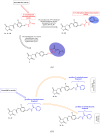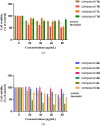The new thiazolidine-2,4-dione-based hybrids with promising antimycobacterial activity: design, synthesis, biological evaluation, and drug interaction analysis
- PMID: 39749402
- PMCID: PMC11703137
- DOI: 10.1080/14756366.2024.2442703
The new thiazolidine-2,4-dione-based hybrids with promising antimycobacterial activity: design, synthesis, biological evaluation, and drug interaction analysis
Abstract
The ever-increasing drug-resistant tuberculosis (TB) has invigorated the focus on the discovery and development of novel therapeutic agents and treatment options. Thiazolidinone-based compounds have shown good antitubercular properties in vitro. Here, we report the design and synthesis of a number of new derivatives inspired by the structure of thiazolidine-2,4-dione (TZD). The TZD-based hybrids with the thiosemicarbazone or the pyridinecarbohydrazone moiety were synthesised and their antimycobacterial activity was investigated against the reference H37Rv and two wild Mycobacterium tuberculosis (Mtb) strains. In further studies, a two-drug interaction analysis was also performed for assessing their synergism with the current first-line drugs used for the treatment of TB. It was found that some of the compounds showed high antimycobacterial activity with MICs (0.078-0.283 µM) and a synergistic effect with isoniazid or rifampicin, thereby demonstrating their potential as a promising scaffold for the development of novel coadjuvants for the effective treatment of TB.
Keywords: Thiazolidine-2,4-diones; antimycobacterial activity; cytotoxicity; structure–activity relationship; synergism.
Conflict of interest statement
The authors report no conflicts of interest.
Figures






Similar articles
-
Review of Recent Advances in Thiazolidin-4-One Derivatives as Promising Antitubercular Agents (2021-Present).Molecules. 2025 May 17;30(10):2201. doi: 10.3390/molecules30102201. Molecules. 2025. PMID: 40430372 Free PMC article. Review.
-
Design, synthesis and antimycobacterial activity of thiazolidine-2,4-dione-based thiosemicarbazone derivatives.Bioorg Chem. 2020 Apr;97:103676. doi: 10.1016/j.bioorg.2020.103676. Epub 2020 Feb 18. Bioorg Chem. 2020. PMID: 32097795
-
Synthesis and antimycobacterial activity of thiazolidine-2,4-dione based derivatives with halogenbenzohydrazones and pyridinecarbohydrazones substituents.Eur J Med Chem. 2020 Mar 1;189:112045. doi: 10.1016/j.ejmech.2020.112045. Epub 2020 Jan 10. Eur J Med Chem. 2020. PMID: 31951961
-
Antimycobacterial evaluation of novel hybrid arylidene thiazolidine-2,4-diones.Bioorg Med Chem Lett. 2014 Feb 15;24(4):1089-93. doi: 10.1016/j.bmcl.2014.01.007. Epub 2014 Jan 11. Bioorg Med Chem Lett. 2014. PMID: 24472146
-
[Development of antituberculous drugs: current status and future prospects].Kekkaku. 2006 Dec;81(12):753-74. Kekkaku. 2006. PMID: 17240921 Review. Japanese.
Cited by
-
Thiosemicarbazone-Based Compounds: Cancer Cell Inhibitors with Antioxidant Properties.Molecules. 2025 May 7;30(9):2077. doi: 10.3390/molecules30092077. Molecules. 2025. PMID: 40363882 Free PMC article. Review.
-
Review of Recent Advances in Thiazolidin-4-One Derivatives as Promising Antitubercular Agents (2021-Present).Molecules. 2025 May 17;30(10):2201. doi: 10.3390/molecules30102201. Molecules. 2025. PMID: 40430372 Free PMC article. Review.
References
-
- Coronavirus (COVID-19). Geneva: World Health Organization; 2022. Available from: https://covid19.who.int/
-
- Global Tuberculosis Report 2023. Geneva: World Health Organization; 2023. Licence: CC BY-NC-SA 3.0 IGO.
-
- Tiberi S, Muñoz-Torrico M, Duarte R, Dalcolmo M, D’Ambrosio L, Migliori G-B.. New drugs and perspectives for new anti-tuberculosis regimens. Pulmonology. 2018;24(2):86–98. - PubMed
-
- WHO consolidated guidelines on tuberculosis. Module 4: treatment – drug-susceptible tuberculosis treatment. Geneva: World Health Organization; 2022. Licence: CC BY-NC-SA 3.0 IGO. - PubMed
MeSH terms
Substances
LinkOut - more resources
Full Text Sources
Other Literature Sources
Molecular Biology Databases
Research Materials
